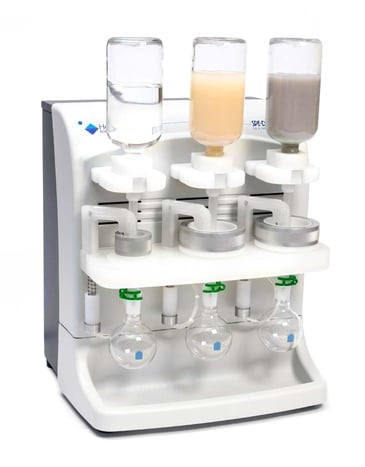Modern Hexane-Extractable Material (Oil & Grease) Analysis in Wastewater Samples
n-Hexane-extractable material (HEM), often termed oil & grease, is an operationally-defined general measurement used around the world to help assess water pollution due to a variety of hydrocarbons, including dissolved aromatics, benzene, toluene, xylene and dispersed polynuclear aromatic hydrocarbons (PAHs), aliphatics, naphthenic and fatty acids.1 Some commonly recognized sources of these compounds include fats, greases, soaps, waxes, and oils.2 It is also used to determine the input into water treatment plants to ensure their continued good operation and to help keep sewer systems from becoming clogged with fats, oil and greases. The measurement of the extracted material is done using a balance in regulatory methods US EPA 1664, ISO 11349 and Standard Methods 5520G, providing a simple and inexpensive detection step.3,4,5 A further silica-gel treatment can be used to isolate the nonpolar material in the n-hexane extract.

Hexane extractables can also be used as a metric to regulate allowable pollution. In the US this is done through a system known as the National Pollutant
Discharge Elimination System (NPDES) where allowable pollution is listed by industrial category for regulation. For example, in the US Code of Federal
Regulations part 40 section 408.12, Subpart A—Farm-Raised Catfish Processing Subcategory, oil & grease, the federal effluent limitation is based on the amount of seafood processed and cannot exceed 10 kg/kkg of seafood on any one day or an average of 3.4 kg/kkg of seafood over the course of a month. Similar regulations are seen in Brazil, Malaysia, the Philippines and other countries

 Organic Workflow
Organic Workflow Peptide Workflow
Peptide Workflow Scale-Up Flash Purification
Scale-Up Flash Purification  Sample Preparation
Sample Preparation Biomolecule Purification
Biomolecule Purification Oligo synthesis
Oligo synthesis Scavengers and Reagents
Scavengers and Reagents Service & Support
Service & Support Accessories & Spare parts
Accessories & Spare parts Investors
Investors Reports & News
Reports & News The Share
The Share Corporate Governance
Corporate Governance Calendar
Calendar Sustainability
Sustainability Our Offering
Our Offering Our History
Our History Our Locations
Our Locations Leadership
Leadership